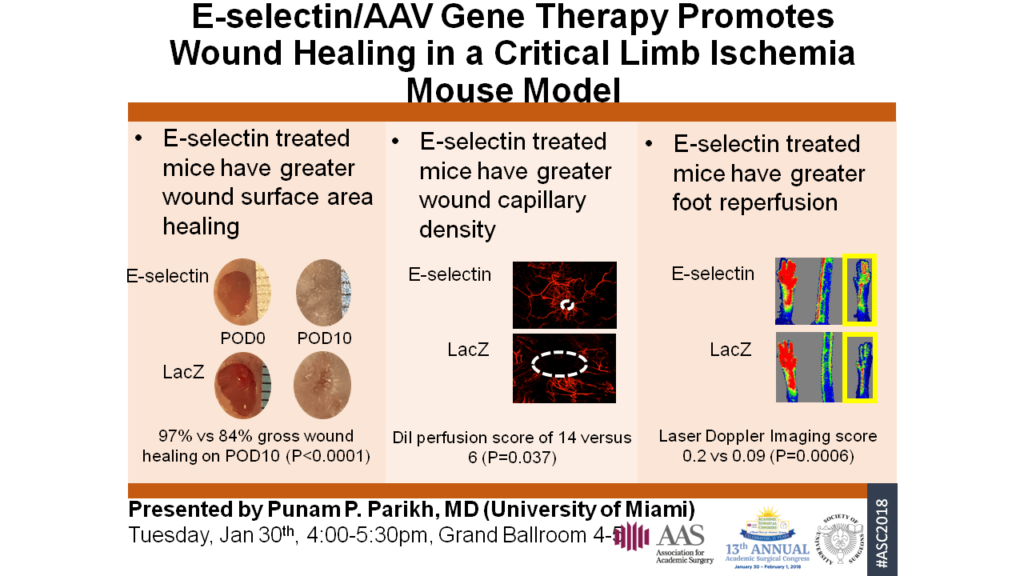P. P. Parikh1, R. Lassance-Soares1, H. Shao1, Z. Liu1, O. C. Velazquez1 1University Of Miami Miller School Of Medicine,Surgery,Miami, FL, USA
Introduction: Poor wound healing in critical limb ischemia (CLI) has been attributed to impaired neovascularization and diminished reperfusion. Optimizing the wound microenvironment by priming wound tissue with adhesion molecules to enhance stem and progenitor cell homing for wound healing may revolutionize the treatment of ischemic wounds. The primary aim of this study involves testing the efficacy of adhesion molecule E-selectin on ischemic wound healing in an ischemic mouse wound model, appraising the possibility of E-selectin-based gene therapy for wound care in CLI.
Methods: Eight-week-old male FVB mice underwent unilateral femoral artery ligation (FAL) to induce CLI. FAL was performed at two sites: immediately below the inguinal ligament and proximal to the sapheno-popliteal bifurcation. Subsequent to FAL, a 4-mm punch biopsy wound was created on the anterior thigh, below the proximal ligation site, to simulate ischemic wounds. Intra-lesion injection of either adenoassociated virus (AAV) carrying E-selectin gene (E-selectin/AAV, n=6) or LacZ gene as control (LacZ+/AAV, n=6) was performed immediately after FAL. Soft-ware assisted measurement of wound healing was performed sequentially for 10 days. Laser doppler imaging (LDI) quantified ischemic hindlimb reperfusion by mean perfusion of ligated:non-ligated limb on postoperative days (PODs) 2 and 8. Using live animal Dil perfusion, wound tissue neovascularization was evaluated by quantification of capillary density in the wound on POD 8. Immunofluorescence verified E-selectin transgene expression in wound vasculature using antibodies against E-selectin and CD31, an endothelial cell marker. Histology of tissues also observed for inflammation and micro-thrombi.
Results: Immunofluorescence confirmed highly effective E-selectin/AAV gene delivery in treatment vs control limbs. No inflammation or micro-thrombi were noted on tissue histology. Wounds from E-selectin/AAV treated mice vs control revealed surface area healing of 55% vs 30% (P=0.005) on POD 1, 81% vs 58% on POD 4 (P=0.0007) and 93% vs 78% on POD 8 (P=0.0001), respectively. LDI revealed greater reperfusion in E-selectin/AAV treated mice vs control by POD 8 (0.2 vs 0.09, respectively; P=0.0006). Live animal Dil perfused ligated hindlimb in E-selectin/AAV treated vs control mice revealed mean neovascularization intensity score of 14 versus 6 (P=0.037) on POD 8.
Conclusion: This study demonstrates the E-selectin/AAV vector as an effective means to achieve elevated levels of E-selectin expression within ischemic wound tissue and blood vessels. Intra-lesion E-selectin/AAV gene therapy of ischemic wounds in mice significantly increased wound angiogenesis and limb reperfusion, expediting overall wound healing.
